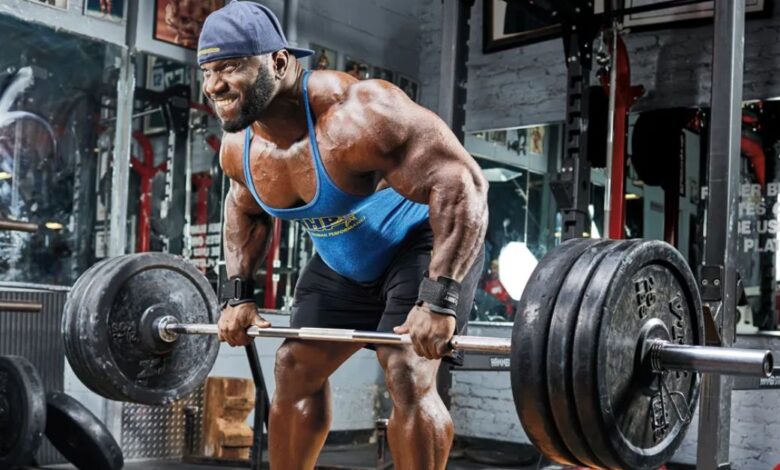wellhealthorganic.com/how-to-build-muscle-know-tips-to-increase-muscles

Want to ditch the “skinny fat” look and build muscle? This comprehensive guide unveils the secrets to muscle growth. Learn about essential exercises, proper nutrition, sleep, recovery, and avoiding overtraining. Get started on your wellhealthorganic.com/how-to-build-muscle-know-tips-to-increase-muscles journey to a stronger, healthier you! Visit wellhealthorganic.com for more info.
Introduction
Ever looked in the mirror and wished for a more defined physique? While sculpted muscles are often associated with bodybuilders, building muscle is a desirable goal for many, regardless of fitness level. A stronger, more muscular body isn’t just about aesthetics; it offers a multitude of benefits, including improved strength, better posture wellhealthorganic.com/how-to-build-muscle-know-tips-to-increase-muscles, enhanced metabolism, and a reduced risk of chronic diseases.
But where do you even begin? Building muscle requires a strategic approach that combines targeted exercise with proper nutrition and adequate rest. If you’re ready to ditch the “skinny fat” look and embark on a muscle-building journey, this comprehensive guide is here to equip you with the knowledge and actionable tips you need to succeed.
Defining Your Goals and Building a Foundation
Before diving headfirst into weightlifting routines and protein shakes, take a step back and establish your goals. What exactly do you hope to achieve? Do you want to gain overall muscle mass, improve your strength for specific sports activities, or sculpt and define certain muscle groups? Having a clear target in mind will guide your workout plan, dietary choices, and overall approach.
Once you’ve defined your goals, it’s crucial to build a solid foundation in terms of exercise technique and general fitness. This might involve familiarizing yourself with basic bodyweight exercises like squats, lunges, push-ups, rows, and planks. You can also explore using resistance bands or light weights to get accustomed to proper form and movement patterns. Consulting a certified personal trainer for personalized guidance, especially during this initial phase, can be immensely helpful in preventing injuries and ensuring you’re targeting the intended muscles effectively.
The Power of Progressive Overload
Muscles are amazing adaptive machines. They respond to stress by becoming stronger and more resilient. This is where the concept of progressive overload comes into play. Essentially, to stimulate muscle growth, you need to constantly challenge them with increasing levels of difficulty. There are several ways to achieve progressive overload:
Increase the weight: As you get stronger with a particular exercise, gradually increase the weight you’re lifting. This can be done by adding more weight plates to barbells or dumbbells, using heavier resistance bands, or opting for more challenging variations of the exercise.
Increase the reps/sets: If increasing the weight feels overwhelming initially, you can progressively overload by performing more repetitions (reps) or sets of each exercise. Aim to reach a point where the last few reps in each set become challenging, indicating that your muscles are being pushed to their limits.
Decrease rest periods: Shortening the rest periods between sets can also increase the overall intensity of your workout, fostering muscle growth. However, ensure you’re not sacrificing proper form for the sake of shorter breaks.
Remember, progressive overload is a gradual process. Don’t try to jump ahead too quickly; listen to your body and increase the difficulty as you get stronger.

Building Your Muscle-Building Arsenal
Now that you understand the importance of progressive overload, let’s delve into specific exercises that target various muscle groups. Here are some foundational exercises to consider incorporating into your workout routine:
Chest: Bench press, incline dumbbell press, decline dumbbell press, push-ups (variations)
Back: Pull-ups (variations), rows (variations), lat pulldown, seated cable rows
Shoulders: Overhead press, lateral raises, front raises, rear delt flyes
Legs: Squats (variations), leg press, lunges (variations), hamstring curls, calf raises
Core: Planks (variations), side planks, Russian twists, crunches (variations)
Don’t Neglect the Power of Compound Movements
While isolation exercises have their place, prioritize compound movements that engage multiple muscle groups at once. Exercises like squats, deadlifts, bench press, rows, and overhead press are highly effective for building overall muscle mass and strength. They not only challenge your major muscle groups but also work your core and stabilizer muscles, leading to a more functional and well-rounded physique.
Fueling Your Muscle-Building Machine
Building muscle is not just about lifting weights; it’s about supplying your body with the necessary building blocks to repair and grow muscle tissue. Nutrition plays a critical role in this process, and a well-designed diet can significantly impact your muscle-building progress. Here’s a deep dive into the essential elements of a muscle-building diet:
The Macronutrient Trio
Macronutrients are the cornerstone of any healthy diet, and for muscle building, the focus falls on three key players: protein, carbohydrates, and fats. Each macronutrient plays a specific role in fueling your workouts, supporting muscle recovery, and providing the energy your body needs to function optimally.
Protein The King of Muscle Building
Protein is often referred to as the “building block” of muscle. It’s essential for muscle repair, growth, and maintenance. When you engage in resistance training, you create microscopic tears in your muscle fibers. These tears are a natural part of the muscle-building process, and protein provides the amino acids your body needs to repair and rebuild these damaged tissues, leading to stronger and more defined muscles.
How Much Protein Do You Need?
The recommended daily protein intake for muscle building can vary depending on several factors, including your body weight, activity level, and training goals. However, a general guideline suggests aiming for 0.8-1 gram of protein per pound of body weight per day. So, for example, if you weigh 150 pounds, you’d be looking to consume around 120-150 grams of protein daily.

Where to Find Protein Powerhouses?
Fortunately, there’s a wide variety of protein-rich foods readily available to incorporate into your diet. Here are some excellent sources:
Lean meats: Chicken breast, turkey breast, lean cuts of beef, bison, pork tenderloin
Fish and seafood: Salmon, tuna, cod, shrimp, sardines
Eggs: A complete protein source containing all essential amino acids
Dairy products: Greek yogurt, cottage cheese, low-fat milk
Plant-based protein: Lentils, beans, tofu, tempeh, quinoa, nuts, and seeds
The Power of Carbohydrates
Carbohydrates are your body’s primary source of energy. They provide readily available glucose, which your muscles rely on for fuel during intense workouts. When you deplete your glycogen stores (the storage form of carbohydrates in your muscles), your performance suffers, and your ability to build muscle diminishes.
Choosing the Right Carbs
Not all carbs are created equal. While sugary snacks and processed foods might provide a quick energy spike, they often lead to blood sugar crashes and leave you feeling sluggish. For muscle building, focus on complex carbohydrates that offer sustained energy release.
Whole grains: Brown rice, quinoa, whole-wheat bread, oats
Starchy vegetables: Sweet potatoes, potatoes, corn
Fruits: Bananas, berries, apples, oranges
Don’t Forget the Healthy Fats
Fat often gets demonized, but healthy fats play a crucial role in a well-balanced diet. They provide essential fatty acids, support hormone production, and contribute to feelings of satiety. Healthy fats also help your body absorb fat-soluble vitamins like A, D, E, and K, which are vital for overall health and well-being.
Healthy fats sources: Avocados, nuts (almonds, walnuts, cashews), seeds (chia seeds, flaxseeds), olive oil, fatty fish

Crafting Your Muscle-Building Meals and Snacks
To support your muscle-building goals, aim to distribute your protein, carbs, and fats throughout the day across multiple meals and snacks. This helps ensure a steady supply of nutrients your body needs for optimal growth and recovery.
Here are some examples of muscle-building meals and snacks:
Breakfast: Greek yogurt with berries and granola, scrambled eggs with whole-wheat toast and avocado
Lunch: Chicken breast with brown rice and steamed vegetables, lentil soup with a whole-wheat roll
Dinner: Salmon with quinoa and roasted Brussel sprouts, turkey chili with whole-wheat crackers
Snacks: Cottage cheese with fruit, protein shake made with whey protein, nuts and seeds, low-fat yogurt with chia seeds
Remember, consistency is key. Sticking to a well-balanced, nutrient-rich diet will provide the fuel your body needs to build muscle effectively. Don’t be afraid to experiment with different food combinations and find what works best for you.
The Often Overlooked Yet Crucial Factor
Water is essential for every bodily function, including muscle growth and repair. During exercise, you lose fluids through sweat, and dehydration can negatively impact your performance, recovery, and even muscle growth. When you’re dehydrated, your body becomes less efficient at transporting nutrients to your muscles and removing waste products. This can lead to fatigue, decreased strength, and muscle cramps.
How Much Water Do You Need?
The recommended daily water intake can vary depending on individual factors like body weight, activity level, and climate. However, a general guideline suggests consuming around half your body weight in ounces of water daily. So, for a 150-pound person, that would translate to roughly 75 ounces of water per day.
Listen to Your Thirst, But Don’t Wait Until You’re Dehydrated
While the above guideline provides a starting point, it’s crucial to listen to your body’s thirst cues. If you’re feeling thirsty, you’re already slightly dehydrated. Aim to sip water throughout the day, even if you don’t feel particularly thirsty. During your workouts, take frequent water breaks to replenish fluids lost through sweat. Consider investing in a reusable water bottle and carrying it with you throughout the day to ensure you’re consistently hydrated.

Electrolytes for Optimal Performance
While water is essential, electrolytes also play a role in hydration and muscle function. Electrolytes are minerals like sodium, potassium, magnesium, and calcium that help regulate fluids in your body and contribute to proper muscle contractions and nerve impulses. During intense workouts, you lose electrolytes along with fluids through sweat.
Replenishing Electrolytes for Peak Performance
While a balanced diet typically provides sufficient electrolytes for most people, athletes and individuals engaged in high-intensity workouts may benefit from additional electrolyte support. Here are some ways to replenish electrolytes:
Electrolyte-enhanced water: Many commercially available bottled water options are fortified with electrolytes.
Natural sources: Include electrolyte-rich foods in your diet, such as fruits (bananas, oranges, coconut water),
vegetables (spinach, potatoes), and dairy products (milk, yogurt).
Electrolyte supplements: Consult with your doctor or a registered dietitian before using electrolyte supplements, especially if you have any underlying health conditions.
Sleep is often an overlooked yet crucial factor in muscle building. During sleep, your body undergoes essential repair and recovery processes. It’s when your body releases growth hormone, a key hormone that stimulates muscle growth and tissue repair. When you’re sleep-deprived, your growth hormone production decreases, hindering your muscle-building efforts.
The Science Behind Sleep and Muscle Growth
Several studies have shown a strong link between sleep and muscle growth. One study published in the Journal of Strength and Conditioning Research found that athletes who slept for 10 hours per night for one week experienced significantly greater muscle gains compared to those who slept for only 5.5 hours per night. Sleep also helps regulate hormones like cortisol, which can break down muscle tissue when levels are elevated.
How Much Sleep Do You Need?
The National Sleep Foundation recommends that adults aim for 7-9 hours of sleep per night for optimal health and well-being. However, individual sleep needs may vary. Pay attention to your body’s cues. If you wake up feeling fatigued or struggle to function throughout the day, you might be sleep-deprived.
Creating a Sleep-Promoting Routine
Developing a consistent sleep schedule is crucial for getting quality sleep. Go to bed and wake up at the same time each day, even on weekends. Create a relaxing bedtime routine that helps you wind down before sleep, such as taking a warm bath, reading a book, or practicing light stretches. Avoid screen time (phones, laptops, TVs) for at least an hour before bed, as the blue light emitted from these devices can interfere with sleep quality.

The Importance of Rest and Recovery
Building muscle is a process, and it takes time and dedication. While pushing yourself in the gym is important, rest and recovery are equally crucial. Your muscles grow and repair themselves during rest periods, not during workouts.
Scheduling Rest Days
Don’t fall into the trap of overtraining. Aim to incorporate at least 1-2 rest days per week to allow your muscles to recover and rebuild. It’s also important to schedule active recovery days, which might involve low-impact activities like walking, yoga, or light stretching. These activities help promote blood flow and remove waste products from your muscles, further aiding the recovery process.
Listen to Pain Signals
While pushing yourself is important for muscle growth, there’s a fine line between challenging yourself and overtraining. Overtraining occurs when you subject your body to excessive physical stress without allowing adequate time for recovery. This can lead to a number of negative consequences, including:
Decreased performance: Overtraining can lead to fatigue, decreased strength, and impaired coordination, all of which can negatively impact your workout performance.
Increased risk of injury: When your muscles are fatigued and overused, they become more susceptible to injuries like muscle strains, tears, and joint pain.
Suppressed immune system: Overtraining can lead to a weakened immune system, making you more susceptible to illnesses like colds and flu.
Mental burnout: Overtraining can also lead to mental burnout, characterized by a loss of motivation, decreased enjoyment of exercise, and difficulty sleeping.
Signs and Symptoms of Overtraining
Here are some common signs and symptoms of overtraining to watch out for:
Persistent fatigue and muscle soreness
Decreased motivation and enjoyment of workouts
Frequent headaches or trouble sleeping
Decreased performance in the gym
Increased susceptibility to illness
Loss of appetite or changes in weight
How to Avoid Overtraining
Here are some tips to help you avoid overtraining and ensure optimal muscle growth:
Incorporate rest days: As mentioned earlier, schedule at least 1-2 rest days per week to allow your body to recover.
Listen to your body: Pay attention to your pain signals. If you’re experiencing persistent pain or discomfort, take a break and allow your body to heal.
Plan your workouts: Design a workout plan that incorporates progressive overload but also allows for adequate recovery time between muscle groups.
Prioritize sleep: Aim for 7-9 hours of quality sleep per night to promote optimal muscle recovery and growth.
Fuel your body properly: Ensure you’re consuming a balanced diet with sufficient protein, carbohydrates, and healthy fats to support your workouts and recovery.
Consider active recovery: Include active recovery days in your routine with low-impact activities like walking, yoga, or light stretching to promote blood flow and aid muscle recovery.
Don’t be afraid to ask for help: If you’re unsure about your workout plan or have concerns about overtraining, consult with a certified personal trainer or registered dietitian for personalized guidance.
Building a Sustainable Muscle-Building Routine
Building muscle is a marathon, not a sprint. Consistency is key to achieving your goals. By incorporating the principles discussed in this guide – proper exercise technique, progressive overload, a balanced diet, adequate hydration, quality sleep, and strategic rest and recovery – you can create a sustainable muscle-building routine that delivers long-term results. Remember, it’s important to find an approach that works for you and fits your lifestyle. Don’t be afraid to experiment and adjust your plan as needed.
The Rewards of Building Muscle
Building muscle is not just about aesthetics; it’s an investment in your overall health and well-being. Muscle tissue plays a vital role in metabolism, bone health, and functional movement. By following the tips outlined in this comprehensive guide, you can embark on a rewarding journey of muscle growth, improved strength, and a more confident you.
Ready to Take Action?
If you’re ready to ditch the “skinny fat” look and build muscle, this guide has equipped you with the knowledge and tools you need to get started. Remember, wellhealthorganic.com offers a wealth of additional resources on muscle building, nutrition, and overall fitness. Explore their website for workout plans, healthy recipes, and expert advice to support you on your muscle-building journey. Happy lifting!
wellhealthorganic.com/how-to-build-muscle-know-tips-to-increase-muscles



